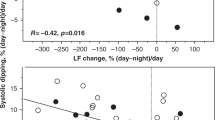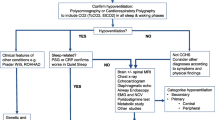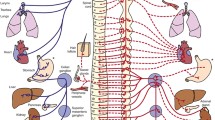Abstract
Background
Children with Congenital Central Hypoventilation Syndrome (CCHS) typically present as newborns with alveolar hypoventilation. With the advent of genetic testing, parents of affected children and other unrelated adults, all heterozygous for the disease-defining PHOX2B polyalanine expansion mutation with the 20/25 genotype, are being identified in adulthood. Though children with PHOX2B mutation-confirmed CCHS demonstrate ANS dysregulation, including altered heart rate and blood pressure control, it is unknown if adults with CCHS have similarly affected autonomic function in blood pressure control.
Methods and Results
An autonomic profile of blood pressure control has been studied with recording of muscle sympathetic activity and spectral analysis of heart rate and blood pressure variability of one adult patient with alveolar hypoventilation and the 20/25 PHOX2B genotype. All parameters of heart rate variability were reduced. Cardiac baroreflex sensitivity was decreased. Sympathetic responses to Valsalva maneuver, hypoxemia, isometric exercise and cold pressor were blunted.
Conclusion
In summary, we found a reduced cardiac baroreflex and a blunted sympathetic mediated response in the individual with adult-onset CCHS, possibly due to dysfunction in the afferent pathway. Our results confirm that PHOX2B affects the development of the autonomic nervous system, possibly causing absence of normal maturation of carotid body and visceral sensory ganglia and leading to autonomic dysfunction in adult-onset CCHS.



Similar content being viewed by others
References
Amiel J, Laudier B, Attie-Bitach T, Trang H, de Pontual L, Gener B, Trochet D, Etchevers H, Ray P, Simonneau M, Vekemans M, Munnich A, Gaultier C, Lyonnet S (2003) Polyalanine expansion and frameshift mutations of the paired-like homeobox gene PHOX2B in congenital central hypoventilation syndrome. Nat Genet 33:459–461
Antic N, McEvoy RD (2002) Primary alveolar hypoventilation and response to the respiratory stimulant almitrine. Intern Med J 32:622–624
Antic NA, Malow BA, Lange N, McEvoy RD, Olson AL, Turkington P, Windisch W, Samuels M, Stevens CA, Berry-Kravis EM, Weese-Mayer DE (2006) PHOX2B mutation-confirmed congenital central hypoventilation syndrome: presentation in adulthood. Am J Respir Crit Care Med 174:923–927
Berry-Kravis EM, Zhou L, Rand CM, Weese-Mayer DE (2006) Congenital central hypoventilation syndrome: PHOX2B mutations and phenotype. Am J Respir Crit Care Med 174:1139–1144
Delius W, Hagbarth KE, Hongell A, Wallin BG (1972) General characteristics of sympathetic activity in human muscle nerves. Acta Physiol Scand 84:65–81
Durand E, Dauger S, Pattyn A, Gaultier C, Goridis C, Gallego J (2005) Sleep-disordered breathing in newborn mice heterozygous for the transcription factor Phox2b. Am J Respir Crit Care Med 172:238–243
Macey PM, Macey KE, Woo MA, Keens TG, Harper RM (2005) Aberrant neural responses to cold pressor challenges in congenital central hypoventilation syndrome. Pediatr Res 57:500–509
Madison JM, Irwin RS (1998) Chronic obstructive pulmonary disease. Lancet 352:467–473
Matera I, Bachetti T, Puppo F, Di DM, Morandi F, Casiraghi GM, Cilio MR, Hennekam R, Hofstra R, Schober JG, Ravazzolo R, Ottonello G, Ceccherini I (2004) PHOX2B mutations and polyalanine expansions correlate with the severity of the respiratory phenotype and associated symptoms in both congenital and late onset Central Hypoventilation syndrome. J Med Genet 41:373–380
O’Brien LM, Holbrook CR, Vanderlaan M, Amiel J, Gozal D (2005) Autonomic function in children with congenital central hypoventilation syndrome and their families. Chest 128:2478–2484
Oppenheim AV, Schafer RW (1996) Digital signal processing. Prentice-Hall, NJ
Pattyn A, Morin X, Cremer H, Goridis C, Brunet JF (1997) Expression and interactions of the two closely related homeobox genes Phox2a and Phox2b during neurogenesis. Development 124:4065–4075
Pattyn A, Morin X, Cremer H, Goridis C, Brunet JF (1999) The homeobox gene Phox2b is essential for the development of autonomic neural crest derivatives. Nature 399:366–370
Penaz J, Voigt A, Teichmann W (1976) Contribution to the continuous indirect blood pressure measurement. Z Gesamte Inn Med 31:1030–1033
Ramanantsoa N, Vaubourg V, Dauger S, Matrot B, Vardon G, Chettouh Z, Gaultier C, Goridis C, Gallego J (2006) Ventilatory response to hyperoxia in newborn mice heterozygous for the transcription factor Phox2b. Am J Physiol Regul Integr Comp Physiol 290:R1691–R1696
Sasaki A, Kanai M, Kijima K, Akaba K, Hashimoto M, Hasegawa H, Otaki S, Koizumi T, Kusuda S, Ogawa Y, Tuchiya K, Yamamoto W, Nakamura T, Hayasaka K (2003) Molecular analysis of congenital central hypoventilation syndrome. Hum Genet 114:22–26
Smith CB, Kanner RE, Golden CA, Klauber MR, Renzetti AD Jr (1980) Effect of viral infections on pulmonary function in patients with chronic obstructive pulmonary diseases. J Infect Dis 141:271–280
Tank J, Baevski RM, Fender A, Baevski AR, Graves KF, Ploewka K, Weck M (2000) Reference values of indices of spontaneous baroreceptor reflex sensitivity. Am J Hypertens 13:268–275
Tank J, Diedrich A, Szczech E, Luft FC, Jordan J (2005) Baroreflex regulation of heart rate and sympathetic vasomotor tone in women and men. Hypertension 25:1159–1164
Task Force (1996) Heart rate variability. Standards of measurement, physiological interpretation, and clinical use. Task Force of the European Society of Cardiology and the North American Society of Pacing and Electrophysiology. Eur Heart J 17:354–381
Trang H, Girard A, Laude D, Elghozi JL (2005) Short-term blood pressure and heart rate variability in congenital central hypoventilation syndrome (Ondine’s curse). Clin Sci (Lond) 108:225–230
Umetani K, Singer DH, McCraty R, Atkinson M (1998) Twenty-four hour time domain heart rate variability and heart rate: relations to age and gender over nine decades. J Am Coll Cardiol 31:593–601
Vallbo AB, Hagbarth KE, Torebjork HE, Wallin BG (1979) Somatosensory, proprioceptive, and sympathetic activity in human peripheral nerves. Physiol Rev 59:919–957
Weese-Mayer DE, Berry-Kravis EM, Marazita ML (2005) In pursuit (and discovery) of a genetic basis for congenital central hypoventilation syndrome. Respir Physiol Neurobiol 149:73–82
Weese-Mayer DE, Berry-Kravis EM, Zhou L (2005) Adult identified with congenital central hypoventilation syndrome—mutation in PHOX2b gene and late-onset CHS. Am J Respir Crit Care Med 171:88
Weese-Mayer DE, Berry-Kravis EM, Zhou L, Maher BS, Silvestri JM, Curran ME, Marazita ML (2003) Idiopathic congenital central hypoventilation syndrome: analysis of genes pertinent to early autonomic nervous system embryologic development and identification of mutations in PHOX2b. Am J Med Genet A 123:267–278
Weese-Mayer D, Shannon D, Keens T, Silvestri J (1999) Idiopathic congenital central hypoventilation syndrome: diagnosis and management. American Thoracic Society. Am J Respir Crit Care Med 160:368–373
Windisch W, Hennings E, Storre JH, Matthys H, Sorichter S (2004) Long-term survival of a patient with congenital central hypoventilation syndrome despite the lack of continuous ventilatory support. Respiration 71:195–198
Woo MS, Woo MA, Gozal D, Jansen MT, Keens TG, Harper RM (1992) Heart rate variability in congenital central hypoventilation syndrome. Pediatr Res 31:291–296
Acknowledgements
This work was supported in part by National Institutes of Health grants M01 RR00095, 1PO1 HL56693, R01 HL71784 and R41 AG19576-01A1. We thank Peter Howard, Sachin Y Paranjape, Bonnie Black, Ginnie Farley, Suzanne Lonce and staff of the Vanderbilt University GCRC for their support. We appreciate the help of Madaline Corridan & Hannah Scott from Mary’s Hospital. We thank Dr. Thomas Hazinski for his kind referral of the patient.
Author information
Authors and Affiliations
Corresponding author
Rights and permissions
About this article
Cite this article
Diedrich, A., Malow, B.A., Antic, N.A. et al. Vagal and sympathetic heart rate and blood pressure control in adult onset PHOX2B mutation–confirmed congenital central hypoventilation syndrome. Clin Auton Res 17, 177–185 (2007). https://doi.org/10.1007/s10286-007-0421-4
Received:
Accepted:
Published:
Issue Date:
DOI: https://doi.org/10.1007/s10286-007-0421-4




